Food for thoughts
Jan. 15, 2023
Compliance: at the moment

♾️ suivre Marie-Anne Frison-Roche sur LinkedIn
♾️ s'abonner à la Newsletter MAFR Regulation, Compliance, Law
____
► Référence complète : M.-A. Frison-Roche, "Si l'algorithme engendre un risque systémique de fraude, l'entreprise doit trouver le moyen de prévenir et détecter celle-ci : cas d'école", Newsletter MAFR Law, Compliance, Regulation, 15 janvier 2023.
____
Le cas agite et inquiète à juste titre. Il est notamment relayé dans Le Parisien et dans Libération.
Il apparait qu'un professeur de master découvre que la moitié de la promotion de ses étudiants avait fait écrire sa copie par un algorithme (ChatGPT), dont on dit que les productions mécaniques se rapprochent, à s'y méprendre, du "langage naturel", c'est-à-dire manié par les êtres humains. Il en a résulté des copies correctes, mais si identiques que l'usage de l'outil par les étudiants avait été ainsi détecté.
La dimension systémique du phénomène mérite qu'on y réfléchisse car il s'agit non seulement de détecter mais encore de prévenir le recours à cet outil, si l'on veut que les travaux rendus par les étudiants permettent d'évaluer leurs niveaux.
L'on peut certes rechercher des solutions très radicales, comme obliger les étudiants à écrire à la main dans des contrôles faits sur table et surveillés..., ou interdire le recours aux algorithmes, interdiction dont l'effectivité va être difficile ; ou rêver d'une Université où l'on leur donnerait des sujets de réflexion à traiter chacun d'une façon originale, ce qui suppose sans doute un nombre d'étudiants moins élevés (d'ailleurs, les lycées et collègues sont aussi concernés).
Mais si l'on regarde le "but" : il s'agit bien de prévenir et détecter un comportement systémiquement dommageable, pour l'Université et pour les étudiants eux-mêmes (qui n'auront rien appris ; ce sont les premières victimes).
Or, la prévention et détection des comportements systémiquement dommageables non pas tant pour les sanctionner mais pour qu'ils ne prospèrent pas à l'avenir, ici garder les avantages des algorithmes comme outils et prévenir leur usage dolosif, c'est la définition du Droit de la Compliance comme mode de prévention et de détection des maux systémique. Cela constitue un "but monumental".
🔴 M.-A. Frison-Roche, 📕Les buts monumentaux de la Compliance, 2022
Pour concrétiser une telle ambition, notamment face à la puissance de ces outils neutres que sont les algorithmes, qui permettent d'ailleurs à des professeurs de rédiger sans difficulté des cours sur l'originalité desquels on ne leur demande pas de compte, le Droit de la Compliance présente un atout majeur : il repose sur les entreprises elles-mêmes, notamment celles par lesquelles le risque est né.
Historiquement, le Droit de la Compliance est né aux Etats-Unis, en imposant aux entreprises ayant contribué par leur comportement interne à la crise de 1929 une série d'obligations de prudence, de gestion des conflits d'intérêts, d'information et de soumission à un superviseur.
🔴 M.-A. Frison-Roche, 📝Compliance : avant, maintenant, après, 2018
C'est en effet aux entreprises de trouver les solutions pour détecter et prévenir les comportements systémiques dommageables.
L'article publié dans Libération fait état des travaux menés par les entreprises fabriquant les algorithmes pour que soient insérés dans les textes des signaux, indétectables par l'usager (par exemple l'algorithme achevant une phrase sur dix par un mot finissant par la même lettre, ou une phrase sur vingt par un mot commençant par la même lettre), mais qu'un autre algorithme pourrait "détecter" pour que le travail produit soit analysé par le professeur (comme on le fait déjà en matière de plagiat).
Il s'agit ici d'une "compliance consentie, choisie par l'entreprise elle-même ; cela pourrait être leur être également imposé.
🔴 L. Benzoni et B. Deffains, 📝Approche économique des outils de la Compliance: finalité, effectivité et mesure de la Compliance subie et choisie, in M.-A. Frison-Roche (dir.), 📕Les outils de la Compliance, 2021
Apparaît ainsi le juste et efficace rapport entre le Droit de la Compliance et ce que l'on appelle "l'intelligence artificielle", dès l'instant que l'on n'a précisément pas une vision mécanique du Droit de la Compliance, ce qui permet de laisser les algorithmes à leur place : des "outils".
🔴 M.-A. Frison-Roche, 🎥Compliance, Intelligence artificielle et gestion des entreprises : la juste mesure, 2022
________
Jan. 7, 2023
Thesaurus : Doctrine
► Référence complète : J. Harrison, "Trade Agreement and Sustainability: Exploring the Potential of Global Value Chain (GVC) Obligations", Journal of International Economic Law, 2023
____
► Résumé de l'article (fait par l'auteur ) : Après
____
🦉Les étudiants de Marie-Anne Frison-Roche peuvent avoir accès au texte intégral
________
Jan. 1, 2023
Thesaurus : Doctrine
► Référence complète : W. Feugère, "Les suites des alertes : observations sur les enquêtes internes", in W. Feugère (dir.), Le nouveau régime des dispositifs d’alerte en France : comment conjuguer conformité et efficacité, Cahiers de droit de l'entreprise (CDE), n° 1, janvier-février 2023, pp. 49-52.
____
►Résumé de l'article (fait par l'auteur) : "L’analyse du droit des alertes ne peut se concevoir que dans celle des enquêtes, qui en sont la suite incontournable. L’alerte est une information brute : elle doit être analysée, au-delà de sa seule recevabilité. Quels sont les faits exacts ? Quelle en est l’ampleur ? Quels en sont les enjeux et les impacts, les responsabilités ? Enfin, et surtout, qu’en conclure, que décider ? Une information doit donner lieu à réflexion et à une décision. L’enquête a précisément cet objectif : mettre en mesure les managers de décider.".
____
🦉Cet article est accessible en texte intégral pour les personnes inscrites aux enseignements de la Professeure Marie-Anne Frison-Roche
________

Updated: Dec. 28, 2022 (Initial publication: July 10, 2022)
Publications

♾️ follow Marie-Anne Frison-Roche on LinkedIn
♾️ subscribe to the Newsletter MAFR Regulation, Compliance, Law
____
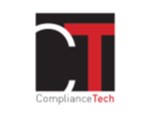 ► Full reference: M.A. Frison-Roche, Regulatory and Compliance Law, expression of the missions of a professional Order, Working Paper, July 2022.
► Full reference: M.A. Frison-Roche, Regulatory and Compliance Law, expression of the missions of a professional Order, Working Paper, July 2022.
____
🎤 This Working Paper has been done as basis for an intervention in the Annual Congress of the French Professional Order of the Géomètres-Experts, September 15, 2022 (conference given in French)
____
🎥watch the short presentation of this speech (in French)
____
🎥watch the full speech given on 15 September 2022, based on this working paper
____
► Summary of the Working Paper: Professional orders should not present themselves as exceptions, however legitimate they may be, in relation to a principle, which would be the competitive system, but as the expression of a principle. This principle is expressed by two branches of Law whose importance is constantly growing in European Law, liberal branches which are based on the conception of economic life and the definition of company, turned towards the future: the Regulatory Law and Compliance Law, two branches of Law at the same time related and distinct.
Indeed, and this is the topic of the first part, Competition Law conceives professional orders as exceptions since these "corporations" constitute structural agreements. French domestic legal system both consolidates the professional orders by backing them up to the State, which would sub-delegate its powers to them, but involves them in the questioning by the European Union of the States and their tools. Most often the temptation is then to recall with a kind of nostalgia the times when the professional orders were the principle but, except to ask for a restoration, the time would be no more.
A more dynamic approach is possible, in accordance with the more general evolution of Economic Law. Indeed, the Professional Order is the expression of a profession, a little-exploited concept in Economic Law, over which the Order exercises the function of "Second-level Regulator", the public authorities exercising the function of "First-level Regulator". The Banking and Financial Regulatory Law is built in this way and operates thank to that, at national, European, and global level. This is what should be linked.
The Professional Orders therefore have the primary function of spreading a "Culture of Compliance" among the professionals they supervise and beyond them (clients and stakeholders). This culture of Compliance is developed regarding the missions which are concretized by the professionals themselves.
Therefore, the second part of the Working Paper deals with the legal evolution of the notion of "Mission" which has become central in Economic and General Law, through the technique of the mission-based company. However, there are multiple points of contact between the raison d'être, the company with a mission and Compliance Law as soon as the latter is defined by the concrete and overly ambitious goals that it pursues. : the Monumental Goals.
Each structure, for example the French Ordre des Géomètres-Experts, is legitimate to set the Monumental Goal that it pursues and that it inculcates, in particular the conception of territory and the living environment, joining what unites all the Monumental Goals of Compliance: concern for others. The French Ordre des Géomètres-Experts, is adequate because it has a more flexible relationship, both tighter and broader, with the territory than the State itself.
By instilling this in professionals, the Professional Order develops in the practitioner an "ex ante responsibility", which is a pillar of Compliance Law, constituting both a charge and a power that the practitioner exercises, and of which the Professional Order must be the supervisor.
____
🔓read the Working Paper⤵️
Dec. 15, 2022
Thesaurus : Doctrine
► Référence complète : P. Larouche, "Pluralisme et multivalence en analyse économique du droit", Revue de droit d'Assas, n°24, déc. 2022, p.126-129.
----
► Résumé de l'article : L'auteur montre que l'on a parfois une vision déformée de l'Analyse économique du Droit. Après avoir souligné que l'interdisciplinarité débute souvent par une "phase de déception initiative", il rappelle les profits de celle-ci à condition que chaque discipline respecte l'autre.
Or, dans l'analyse économique du droit, chacun s'est souvent bloqué, l'on en reste souvent au premier stade.
Sans doute, parce que ce mouvement né aux Etats-Unis il y a 60 ans, participait alors au mouvement de l'époque visant à faire de l'économie "une science à part entière à l'instar des sciences naturelles", mais ne prétendait pas décrire le monde ni constituer un système de preuves.
Ce n'est que plus tard que la "théorie du coût social" de Coase (1960) a été perçue comme pouvant s'appliquer à tout, ce que l'auteur ne prétendait pas.
Ce n'est qu'en 1970 que Posner y associe ce qui serait une supériorité du Common Law, le courant Law and Economics étant rejeté par les non anglo-américains.
Mais ce double lien entre la conception très libérale de 1960 et très culturelle de 1970 n'est pas intrinsèque à l'AED.
En outre, pour Coase, les coûts de transactions sont faibles, parce qu'ils sont engendrés par le système juridique lui-même. Aujourd'hui, on admet au contraire qu'ils sont élevés parce qu'ils constituent par l'ensemble du système juridique, l'AED intégrant le pluralisme juridique.
Dès lors, le Droit reprend face à l'Economie à la façon sa spécificité et son ampleur.
L'AED ne peut plus aussi facilement que dans la conception précédente en tirer des conséquences normatives, où la réglementation américaine semblait pouvoir engendrer des solutions applicables partout parce qu'enrichie par l'analyse économique.
Corrélativement, le Droit doit moins rejeter l'analyse économique, dès l'instant que ce qu'est le Droit y est respecté, notamment l'économie de l'information.
________
Dec. 11, 2022
Compliance: at the moment

♾️ suivre Marie-Anne Frison-Roche sur LinkedIn
♾️ s'abonner à la Newsletter MAFR Regulation, Compliance, Law
____
► Référence complète : M.-A. Frison-Roche, "Youporn. La question est : comment appliquer les textes ? Pour arriver à quelque chose", Newsletter MAFR Law, Compliance, Regulation, 11 décembre 2022.
____
Ceux qui furent huissiers de justice et ceux qui furent commissaires-priseurs sont désormais unis dans la profession des Commissaires de justice.
Leur premier congrès annuel s'est tenu les 8 et 9 décembre 2022 à Paris.
Aux chocs de la crise, du covid, de l'impression générale que de l'avenir l'on ne connait plus rien s'ajoute ce choc d'une unité à accroitre et à maintenir dans le temps, non seulement dans la profession mais avec les autres (une profession qui s'enferme meurt, si protégée soit-elle).
C'est sans doute pour cela que le Congrès débuta le 8 décembre au matin par un débat de 2 heures avec les autres : non seulement les notaires, pas encore les greffiers, le ministère de la justice et l'autorité de la concurrence.
De cet échange, il ressort que l'on compte sur la force des professions réglementées et que celle-ci s'exprime notamment par le Droit de la Régulation et de la Compliance.
En effet, les "professions" sont des structures qui ont un grand avenir, en ce qu'elles s'articulent avec le système économique libéral, qu'elles sont par nature régulées et porteuses de régulation, dans des systèmes qui, pour demeurer libéraux, vont en avoir de plus en plus besoin. Cela est pertinent pour la profession des Commissaires de justice qui procurent de la sécurité, via de l'incontestabilité reposant aussi sur le lien entre celle-ci et les faits, et qui assurent l'effectivité des engagements en gardant le souci du lien social.
Assurer la crédibilité de ce qui est constaté, de ce qui est vendu, c'est un service essentiel.
Lorsqu'il devient difficile d'exécuter des engagements, avoir un tiers de confiance est un maillage essentiel entre créancier et débiteur, dans une démarche qui n'a rien de mécanique.
Plus encore, la place de la Compliance va s'accroitre. Dépassant l'exigence de "conformité", qui n'est qu'un outil de la Compliance, l'avenir du Droit de la Compliance se noue avec celui des professions, notamment dans l'Europe qui associe dynamisme économique, souci des personnes et de l'environnement, et l'alliance que cela implique entre les Autorités politiques et publiques et les entités susceptibles de participer à la concrétisation de ces Buts Monumentaux de la Compliance.
📕 Pour aller plus loin : M.-A. Frison-Roche (dir.), Les buts monumentaux de la compliance, 2022.
______
Dec. 8, 2022
Conferences
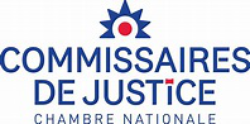
♾️ suivre Marie-Anne Frison-Roche sur LinkedIn
♾️s'abonner à la Newsletter MAFR Regulation, Compliance, Law
____
► Référence complète : M.-A. Frison-Roche, "La compliance, perspective dynamique pour exprimer la raison d'être des commissaires de justice", in Table-ronde sur "Professions réglementées, ambitions et enjeux", Congrès annuel national des Commissaires de justice, Paris, 8 décembre 2022.
____
►lire le programme complet du congrès et 🎥regarder la présentation du colloque par le président du Congrès
____
____
►présentation de l'intervention : Ce premier congrès annuel national des Commissaires de justice, réunissant pour la première fois la profession réformée, a débuté par un débat de 2 heures animé par une journaliste, débat entre les autres professions, les autorités publiques (Autorité de la concurrence, Chancellerie), ayant pour ma part à y apporter le regard académique :
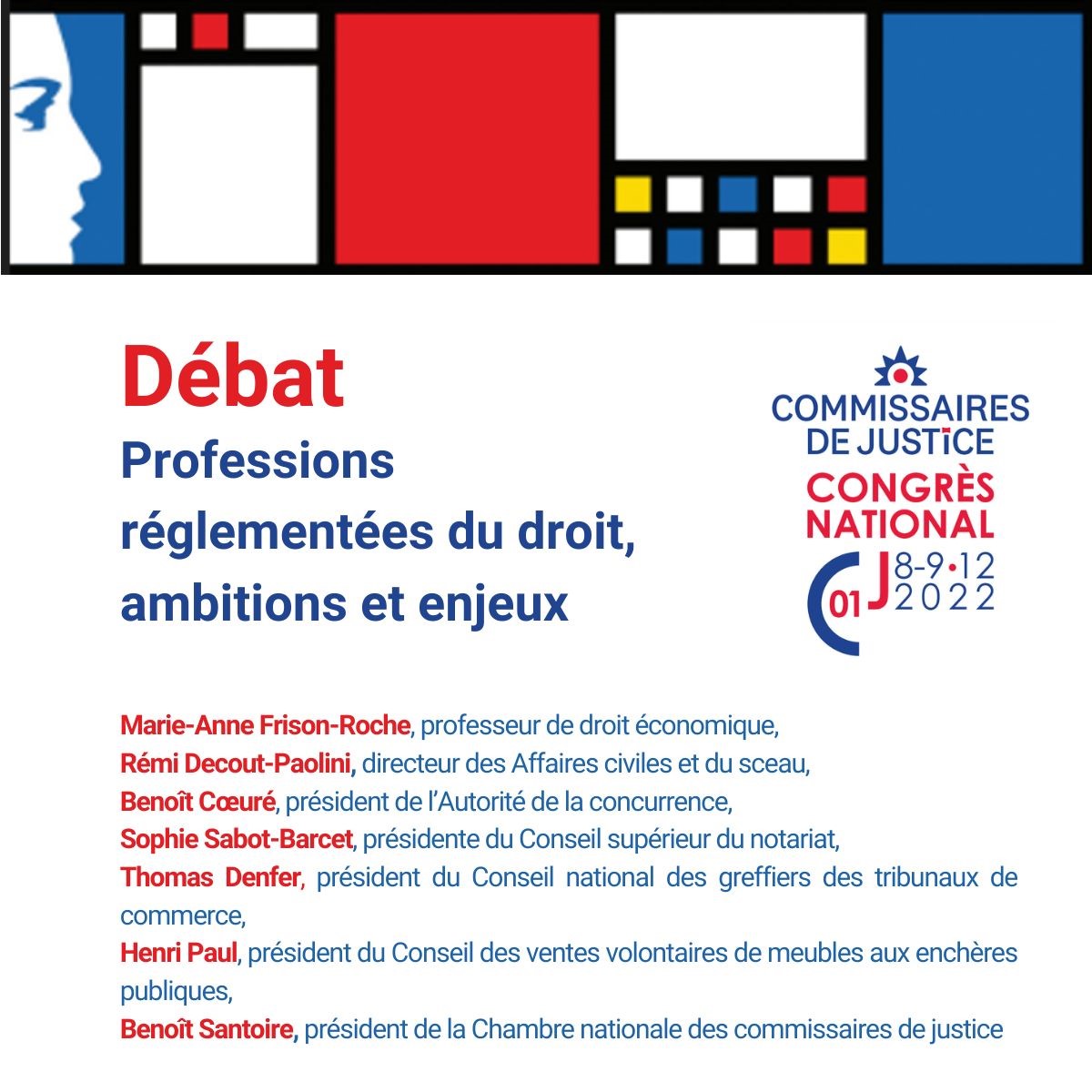
Ce débat fut particulièrement animé et vivant, ne serait-ce qu'en raison de la configuration des lieux, chacun étant placé pour entrer dans un dialogue :

🎤 J'y pris la parole en premier pour insister sur le fait que les "professions" sont des structures qui ont un grand avenir, en ce qu'elles s'articulent avec le système économique libéral, qu'elles sont par nature régulées et porteuses de régulation, dans des systèmes qui, pour demeurer libéraux, vont en avoir de plus en plus besoin. Cela est pertinent pour la profession des Commissaires de justice qui procurent de la sécurité, via de l'incontestabilité reposant aussi sur le lien entre celle-ci et les faits, et qui assurent l'effectivité des engagements en gardant le souci du lien social.
🎤 J'ai repris la parole lorsque la place de la Compliance fut évoquée. Dépassant l'exigence de "conformité", qui n'est qu'un outil de la Compliance, j'ai montré l'avenir du Droit de la Compliance, notamment dans l'Europe qui associe dynamisme économique, souci des personnes et de l'environnement, et l'alliance que cela implique entre les Autorités politiques et publiques et les entités susceptibles de participer à la concrétisation de ces Buts Monumentaux de la Compliance.
📕 Pour aller plus loin : M.-A. Frison-Roche (dir.), Les buts monumentaux de la compliance, 2022.
________

regarder la présentation du colloque par le président du Congrès

Dec. 5, 2022
Teachings : Participation à des jurys de thèses

♾️ suivre Marie-Anne Frison-Roche sur LinkedIn
♾️s'abonner à la Newsletter MAFR Regulation, Compliance, Law
____
► Référence complète : M.-A. Frison-Roche, membre du jury de la thèse d'Antoine Oumedjkane, Compliance et droit administratif, Université de Montpellier, Salle des Actes, Université de Montpellier, 5 décembre 2022, 14h-
____
🪑🪑🪑Autres membres du jury :
🕴🏻Pascale Idoux, directrice de la thèse
🕴🏻Lucie Cluzel-Métayer, rapporteure
🕴🏻Aude Rouyère, rapporteure
🕴🏻Thomas Perroud, professeur à l'Université Panthéon-Assas (Paris II)
____
► La thèse a été ultérieurement publié : cliquer ICI
____
Dec. 1, 2022
Publications

🌐 follow Marie-Anne Frison-Roche sur LinkedIn
🌐subscribe to the Newsletter MAFR Regulation, Compliance, Law
____
► Full Reference: M.-A. Frison-Roche, "Contrat de compliance, clauses de compliance", Chronique of Compliance Law, D.2022, p.2115-2117.
____
📝reac the article (this article is written in French)
____
► English summary of the article: Compliance Law is often seen only as an obligation to comply with regulations. Contract Law is masked by the study of texts and sanctions. Civil liability cases are beginning to highlight the commitments of companies, acts of will. It remains to discern the importance of contracts.
First, there is a specific contract: the "compliance contract". Its purpose is to provide a third party with a service, the means for the company to "comply" with the legal systems requirements ("contract of conformity"), and/or to enable the company to achieve the monumental goals that characterize Compliance Law (contract of compliance). The interpretation and the regime of these compliance contracts must be marked by the Compliance Law that permeates it. Secondly, there are a multitude of stipulations aimed at conformity and Compliance.
____
🚧read the working paper written in English: Compliance contract, Compliance stipulations
____
📚read the other articles published in this chronique of Compliance Law published in the Recueil Dalloz.
________
Nov. 18, 2022
Conferences
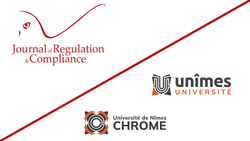
♾️ suivre Marie-Anne Frison-Roche sur LinkedIn
♾️s'abonner à la Newsletter MAFR Regulation, Compliance, Law
____
► Référence complète : M.-A. Frison-Roche, "Le juge, tiers régulateur des obligations contractuelles de compliance", in Journal of Regulation & Compliance (JoRC) et Université de Nîmes, Laboratoire CHROME, Compliance et Contrat : les acteurs et leurs stratégies, Nîmes, 18 novembre 2022.
____
🏗️Cette conférence prend place dans le cycle de colloques, organisé par le Journal of Regulation & Compliance (JoRC) et les Universités qui sont ses partenaires académiques, pendant l'année 2022/2023 autour du thème général L'obligation de compliance.
____
🎤 consulter la synthèse également faite de ce colloque
____
🧮Consulter le programme complet de cette manifestation
____
🚧lire le document de travail servant de base à cette conférence
____
📝Cette conférence sera la base d'un article, à paraître dans un ouvrage qui en résultera, dans sa version française, dans la collection 📚Régulation & Compliance coéditée entre le JoRC et les Editions Dalloz, et dans sa version anglaise, dans la collection 📚Compliance & Regulation coéditée entre le JoRC et les Editions Bruylant.
____
Nov. 17, 2022
Conferences
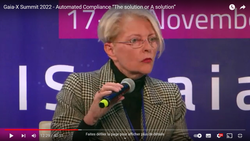
♾️ follow Marie-Anne Frison-Roche on LinkedIn
♾️subscribe to the Newsletter MAFR Regulation, Compliance, Law
____
► Full Reference: M.-A. Frison-Roche, "The distinction between the part and the whole", contribution of the Chapter 2 of the third global Summit of Gaia-X, Chapter on Automated compliance: "the" solution or "a" solution?, November 17, 2022, Paris.
____
This intervention took place in a panel moderated by🕴️Hubert Tardieu, Board of Direction Gaia-X, with:
🕴️Martine Gouriet, Board of Direction Gaia-X and Directrice des Usages numériques EDF – DSIG
🕴️Jakob Rehof, Chair, Software Engineering, Technical University Dortmund Faculty of Computer Science and Director Research Strategy, Fraunhofer-ISST
🕴️Joëlle Toledano, Conseil National du Numérique (CNNum), Chaire Gouvernance & Régulation (Université Dauphine) – Emeritus Professor
____
🧮see the Summit general programme programme
____
🚧read the working paper, basis of this intervention.
____
🎥 see this intervention and debate
____
📝read the presentation of the intervention done in the GaiaX Global Summit of 2020
________
Nov. 9, 2022
Thesaurus : Doctrine

► Référence complète : B. Lehaire, L'innovation hors-la-loi. Les origines de la techno-normativité, Bruylant, coll. "Penser le droit", 2022, 275 p.
____
____
📗lire le sommaire de l'ouvrage
____
📗lire la table des matières de l'ouvrage
____
► Résumé de l'ouvrage (fait par l'éditeur) : "Le droit est-il incapable d’encadrer l’innovation technologique ? L’idée est véhiculée ici et là comme un constat désarmant toute tentative de légiférer sur le "nouveau", en raison principalement du rythme incessant de l’innovation.
L’innovation est devenue un phénomène total entrainant des conséquences sociales réelles.
La principale est sans doute l’injonction faite à tous de l’accueillir, quand il ne s’agit pas de l’encourager. Tous les champs de la société sont concernés, y compris le champ juridique.
En droit, l’injonction normative tend à faire émerger ce qu’il convient désormais d’appeler une techno-normativité, entendue comme la potentielle normativité juridique de la technique.
Ce livre, unique sur le marché, propose une réflexion sur le rôle du droit dans notre société, à la fois comme vecteur de techno-normativité mais aussi comme solution ou limitation des effets négatifs de la technologie sur la société.
En partant des écrits les plus récents sur la philosophie, la sociologie et le monde numérique, l’ouvrage propose une lecture critique du rapport entre droit et innovation qui intéressera tant un public universitaire qu’un public de professionnels du numérique.".
________
Nov. 7, 2022
Thesaurus : Doctrine
► Référence complète : B. Lecourt, "La "directive RSE 2" ("directive CSRD") : le nouveau visage de l'information en matière environnementale et sociale", Rev. sociétés, novembre 2022, chron., pp.639-644
____
► Résumé de l'article :
____
🦉Cet article est accessible en texte intégral pour les personnes inscrites aux enseignements de la Professeure Marie-Anne Frison-Roche
________
Oct. 26, 2022
Hearings by a Committee or Public organisation

🌐follow Marie-Anne Frison-Roche on LinkedIn
🌐subscribe to the Newsletter MAFR. Regulation, Compliance, Law
____
► Full Reference: M.-A. Frison-Roche, Audition as amica curiae by the Paris First Instance Civil Court, in summary proceedings, on the Compliance System and the place of the duty of vigilance in it, 26 October 2022
____
The hearing was held in the presence of two other amici curiae, also appointed by the Court: Professors Jean-Baptiste Racine and Bruno Deffains.
The hearing was requested by and on the initiative of the Paris First Instance Civil Court in connection with a dispute between associations and TotalEnergie, the former alleging breaches of due diligence by the latter, and the Court asking highly qualified individuals to shed light on the Compliance System and its implications.
_____
📝read the hearing report published on 27 October 2022 by Olivia Dufour (Actu-juridique)
📝read the article reporting on the hearing of 7 December 2022, representing the presentation of Compliance Law by MaFR, published on 7 December 2022 by Mathilde Golla (Les Echos)
📝read the article on the use of amicus curiae, starting with the use made in this case, published on 8 December 2022 by Nicolas Cayrol (Recueil Dalloz)
________
Oct. 24, 2022
Thesaurus : Convention, contract, settlement, engagement
► Référence complète : S. Merabet, Le Digital Services Act : guide d’utilisation de lutte contre les contenus illicites", JCP G, n° 42, octobre 2022, doctr. 1210, pp. 1958-1964
____
► Résumé de l'article (fait par l'auteur) : "Le Digital Services Act ambitionne de responsabiliser davantage les fournisseurs de services d’intermédiaires. Si les règles favorables de responsabilité qui leur profite demeurent très largement inchangées, le texte multiplie les obligations à leur charge. Les autorités européennes entendent en finir avec des règles qui pour l’heure permettent trop souvent aux hébergeurs de se soustraire au contrôle des contenus en ligne. Ce sont essentiellement les plateformes qui sont concernées, avec une attention toute particulière portée aux plus grandes d’entre elles. Le règlement conserve des obligations antérieures, en renforce d’autres et surtout en consacre de nouvelles. Ces obligations n’ont pas toute la même intensité, mais certaines devraient avoir une influence déterminante sur les pratiques des plateformes à l’avenir. L’objectif principal du texte est de lutter contre les contenus illicites et son architecture est pensée à cette fin sans pour autant sacrifier les droits des destinataires des services.".
____
🦉Cet article est accessible en texte intégral pour les personnes inscrites aux enseignements de la Professeure Marie-Anne Frison-Roche
________
Oct. 23, 2022
Thesaurus : Doctrine
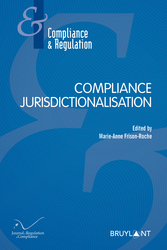
► Full Reference: F. Ancel, "Compliance Law, a new guiding principle for the Trial?", in M.-A. Frison-Roche (ed.), Compliance Jurisdictionalisation, Journal of Regulation & Compliance (JoRC) and Bruylant, coll. "Compliance & Regulation", to be published.
____
📘read a general presentation of the book, Compliance Jurisdictionalisation, in which this article is published
____
► Summary of the article (done by the Journal of Regulation & Compliance): Through this article, the author formulates a proposal: elevating the principle of compliance to the rank of leading principle of the trial. To support this, the author firstly emphasizes the convergence of the aims of compliance and the purpose of the trial. Indeed, emphasizing that Compliance Law does not oust either the State or the judge, as soon as compliance means that the person must keep their commitments and that the trial is also based on this principle that the parties must conform to the principles and to their own "speech", compliance thus becomes a trial leading principle.
In a second part of the article, the author illustrates his point in a very concrete way. First, the protocols of procedure which are drawn up by the courts and the bars are commitments which should justify a form of constraint which, if it should not have the same form and nature as that of the law, must all the same even have consequences when a party fails to do so. Secondly, relying on French case law which sanctions a party which had accepted the principle of an arbitration and then systematically hinders its implementation, the author suggests that under the principle of compliance can be grouped the notions for the instant scattered of loyalty, consistency (estoppel) and efficiency.
Thus, this "open practice" echoing the "open way" of a procedural principle of compliance brings out this one.
____
🦉This article is available in full text to those registered for Professor Marie-Anne Frison-Roche's courses
________
Oct. 20, 2022
Thesaurus : Doctrine

► Full Reference: F.-X. Train, "Arbitration and parallel proceedings exercised in Compliance Procedure", in M.-A. Frison-Roche, M.-A. (ed.), Compliance Jurisdictionalisation, series "Compliance & Regulation", Journal of Regulation & Compliance (JoRC) and Bruylant, to be published.
___
► the summary below describes the article that follows an intervention in the scientific manifestation Compliance et Arbitrage, co-organised by the Journal of Regulation & Compliance (JoRC) and the University Panthéon-Assas (Paris II). This conference was designed by Marie-Anne Frison-Roche and Jean-Baptiste Racine, scientific co-directors, and took place in Paris II University on March 31, 2021.
In the book, the article will be published in the Chapter III, devoted to: Compliance et Arbitrage international.
___
► Article Summary: Firstly, the article insists on the principle of the autonomy of the international arbitration procedure, in relation to which parallel procedures remain watertight, whether they are criminal or done under Compliance Law. In the arbitral proceedings taking place independently, the arbitrators before whom the facts also referred to in these parallel proceedings, in particular the facts of corruption, are alleged before them as facts through their unlawful nature: it is at this title that they can and must apprehend them, using the standard of proof which is the bundle of clues.
Secondly, the article highlights the limits of the autonomy of international arbitration. These may be de facto limits because in the search for evidence by arbitrators, red flags are often insufficiently consistent evidence to establish a sentence, especially since this sentence may be subject to control by the judge of its conformity to international public order, the annulment by the judge being able to be based on external elements, even after the arbitration procedure. It may then be wise for the arbitrators, who are not forced to do so, to suspend their proceedings to wait the results of the parallel proceedings initiated under Compliance Law, so that the procedures and their results could be harmonious.
____
__________
Oct. 17, 2022
Thesaurus : Doctrine
► Référence complète : S. Merabet, "Le Digital Service Act : permanence des acteurs, renouvellement des qualifications", JCP G, n° 41, octobre 2022, doctr. 1175, pp. 1901-1907
____
► Résumé de l'article (fait par l'auteur) : "Le droit du numérique n’en finit pas de se renouveler à l’initiative des autorités européennes. Digital Martek Act, AI Act, proposition de règlement MiCA... Les textes - adoptés ou en cours de négociations - sont nombreux et augurent d’importantes transformations. Le Digital Services Act récemment adopté est sans doute l’un des textes les plus ambitieux aux conséquences les plus immédiates pour les citoyens des États membres de l’Union européenne. Le règlement va profondément affecter les pratiques des services d’intermédiaires et tout particulièrement les plateformes. Deux aspects sont à ce titre déterminant : d’abord, la création de nouveaux acteurs et ensuite la consécration de nouveaux droits et obligations. Ces deux facteurs sont de nature à changer la donne pour les plateformes au cours des prochaines années et chacun d’entre eux sera abordé au travers de deux Études distinctes.".
____
🦉Cet article est accessible en texte intégral pour les personnes inscrites aux enseignements de la Professeure Marie-Anne Frison-Roche
________
Oct. 12, 2022
Editorial responsibilities : Direction of the collection "Cours-Série Droit privé", Editions Dalloz (33)

►Référence complète : D. Mainguy, Contrats spéciaux, Coll. "Cours Dalloz-Série Droit privé", 13ième éd., Dalloz, 2022, 701 p.
____
►Présentation de l'ouvrage : dans ce "Cours" destiné aux étudiants comme aux praticiens, Daniel Mainguy expose les règles techniques propres aux différents contrats spéciaux suivant qu'ils portent sur une chose ou sur un service.
Pour chaque contrat spécial, l'ouvrage expose les règles qui lui sont propres et qui puisent à la fois dans le Code civil et des lois qui lui sont propres, ainsi qu'à la jurisprudence qui s'est accumulée à son propos.
"Contrats usuels" autant que "contrats spéciaux", ils reflètent toute notre vie, de la plus quotidienne (vente, prêt, etc.) aux montages les plus sophistiqués.
____
📚Consulter l'ensemble de la collection dans lequel l'ouvrage est publié.
Dans cette collection, cet ouvrage est plus particulièrement corrélé aux ouvrages suivants :
📕R. Cabrillac, Droit des obligations
📕J.-B. Seube, Droit des suretés
📕J.-D. Pellier, Droit de la consommation
📕S. Piedelièvre, Instrument de crédit et de paiement
📕Ph. Pétel, Procédures collectives
________
Oct. 12, 2022
Conferences

♾️ follow Marie-Anne Frison-Roche on LinkedIn
♾️subscribe to the Newsletter MAFR Regulation, Compliance, Law
____
 ► Full Reference: Frison-Roche, M.A., La compliance en entreprise : aspects théoriques et pratiques, in 118ième Congrès des Notaires, L'ingénierie notariale, Marseilles, October 12, 2022.
► Full Reference: Frison-Roche, M.A., La compliance en entreprise : aspects théoriques et pratiques, in 118ième Congrès des Notaires, L'ingénierie notariale, Marseilles, October 12, 2022.
This Masterclass is given in French.
____
► English Presentation of this Masterclass: This two-hour Masterclass aims to introduce, regarding the role of the Notary in companies and vis-à-vis them, Compliance Law.
This discover of Compliance Law is built on a description of the new Compliance techniques of which companies are the object or the source (I) then, faced with such a mass of new standards, because this is incomprehensible and uncontrollable if these so many regulations are not "conceived", explain what can give meaning to this Compliance Law, namely the "Monumental Goals" which animate it and give it meaning (II). Like the Regulation Law that Compliance prolongs, Compliance Law is a teleological branch of law that requires that the application and interpretation of norms be done by these Monumental Goals.
____
This Masterclass is given in French: see some technical references in English ⤵️
Oct. 12, 2022
Thesaurus
Référence complète : Jaune, R., Règles pénales et administratives de la lutte anticorruption : l'influence des normes étrangères et internationales, Revue française d'administration publique, 2020/3, n°175, p.645-659.
____
Oct. 11, 2022
Editorial responsibilities : Direction of the collection "Cours-Série Droit privé", Editions Dalloz (33)

►Référence complète : M. Véron et G. Beaussonie, Droit pénal des affaires, Dalloz, Coll. "Cours Dalloz-Série Droit privé", 13ième éd., 2019, 739 p.
____
►Présentation de l'ouvrage : dans une présentation renouvelée, ce manuel fait le tour d'une matière caractérisée par la diversité de ses sources. Il insiste sur le fait que de plus en plus cette matière relève du droit économique tout autant que du droit pénal, ce qui a une incidence sur le régime des règles applicables et des solutions retenues.
En outre, le Droit pénal des affaires est marqué aujourd'hui par une transformation vers une répression administrative, une perspective internationale accrue et une entrée en force du Droit constitutionnel.
____
📚Voir l'ensemble des ouvrages de la même collection "Cours Dalloz -Série Droit privé"
et notamment
________
Oct. 10, 2022
Thesaurus : Doctrine
► Référence complète : D. Weihrauch, S. Carodenuto, S. Leipold, "From voluntary to mandatory corporate accountability: The politics of the German Supply Chain Due Diligence Act" ("De la responsabilité volontaire à la responsabilité obligatoire des entreprises : La politique de la loi allemande sur la chaîne de valeur et la vigilance"), Regulation & Governance, octobre 2022.
____
► Résumé de l'article (fait par les auteurs, en anglais) : Following a long-standing and highly contested policy debate, in June 2021, the German parliament passed the Supply Chain Due Diligence Act requiring mandatory due diligence (MDD) of large companies, holding them accountable for the impacts of their supply chain operations abroad. Applying the discursive agency approach and using evidence from policy documents and 21 interviews with key stakeholders, we analyze the political strategies that paved the way toward MDD in Germany. The decisive strategy was an innovative benchmarking and monitoring mechanism that provided the legitimacy for a law and opened a window of opportunity for MDD supporters. Civil society and supportive politicians used this window of opportunity to build broad political coalitions that included the support of some companies. We discuss the ramifications of these findings for understanding the domestic politics behind the newly emerging norm of foreign corporate accountability.
________
Oct. 5, 2022
Interviews

🌐suivre Marie-Anne Frison-Roche sur LinkedIn
🌐s'abonner à la Newsletter MAFR Regulation, Compliance, Law
____
► Référence complète : M.-A. Frison-Roche, " Youporn : Le Droit doit se renouveler face à la transformation du monde par l'espace numérique", entretien avec Olivia Dufour, Actu-juridique, 5 octobre 2022.
___
💬Lire l'entretien dans son intégralité
____
Lire l'entretien précédent : 💬L'efficacité de la Compliance illustrée par l'affaire Youporn
____
► Présentation de l'entretien par le journal : "Comment parvenir à bloquer efficacement l’accès des mineurs aux contenus pornographiques sur internet ? C’est à cette difficile question que s’est attaquée l'Arcom (Autorité de régulation de la communication audiovisuelle et numérique). Avec pour l’instant un succès mitigé. Début septembre, alors que le régulateur demandait au juge de bloquer les cinq sites n’ayant pas obéi à son injonction de modifier leurs conditions d’accès, la justice a décidé de renvoyer le dossier devant un médiateur. Entre temps, un rapport sénatorial publié le 28 septembre souligne l’urgence d’agir. Nous avons demandé au professeur Marie-Anne Frison-Roche, spécialiste de droit de la compliance, comment à son avis il est possible de lutter efficacement contre les dérives de l’industrie pornographique".
____
► Questions posées :
- Dans l'affaire Youporn, la décision du tribunal judiciaire de renvoyer le dossier vers la médiation a suscité un certain émoi. N'est-ce pas le signe d'une forme de renoncement de la justice, avec tout ce que cela implique d'un point de vue symbolique ?
- En quoi le droit de la compliance serait-il plus efficace que les méthodes traditionnelles ?
- Mais n’est-ce pas, d’une certaine façon leur permettre de s’autoréguler, solution que précisément le rapport sénatorial écarte radicalement, estimant qu’elle n’est pas efficace ?
- Le problème, à en croire les sites concernés, c’est qu’il n’y aurait pas de solution qui soit à la fois efficace et respectueuse de la protection de la vie privée…
- Pensez-vous que la compliance ait une chance de réussir là où les outils plus traditionnels connaissent un échec relatif ?
________
Oct. 1, 2022
Thesaurus : Doctrine
► Référence complète : J.-Ch. Roda, "Un an de droit de la concurrence dans l’univers numérique", Communication - Commerce électronique, n° 10, octobre 2022, chron. "Un an de..." n°12
____
► Résumé de l'article (fait par l'auteur) : "Initiée en octobre 2021, la présente chronique se propose de faire un tour d’horizon de l’actualité du droit de la concurrence, appliqué au secteur du numérique. Plus exactement, il s’agit de dresser un panorama, nécessairement subjectif et partiel, des décisions, jurisprudences ou textes qui ont marqué l’actualité, en France et en Europe. Depuis l’an dernier, on peut dire que l’étau ne s’est pas desserré sur les plateformes. La Commission européenne, mais également l’Autorité de la concurrence, ont continué à enquêter et agir contre les grandes plateformes, mais aussi contre différents acteurs du numérique peu scrupuleux. Surtout, l’année écoulée a vu l’adoption définitive du fameux Digital Markets Act, qui promet d’être un des instruments les plus importants pour la régulation du secteur numérique... à condition que les moyens et effectifs alloués soient au rendez-vous. L’adoption de ce règlement est un signal fort en direction des GAFAM... mais aussi des États-Unis qui songent de plus en plus ouvertement à légiférer sur le sujet. Une bataille d’influence se prépare donc du côté de l’antitrust américain. Si les projecteurs sont ainsi braqués sur le « grand droit de la concurrence », le « petit droit » n’a pas été en reste au cours de la période sous chronique. Plus discrètement, mais sûrement, les juges du fond français testent leurs outils plus traditionnels pour tenter de rééquilibrer les rapports de force entre les plateformes et leurs partenaires économiques, avec un certain succès. Autre élément notable durant la période : le droit de la concurrence ne se préoccupe désormais plus uniquement de concurrence stricto sensu, mais semble s’ouvrir vers d’autres champs. Le but de cette chronique n’est toujours pas d’être exhaustif : l’on cherchera plutôt à dessiner les grandes tendances du secteur, en envisageant les textes, puis les décisions et jurisprudences importantes.
1. - Les textes : le Digital Markets Act pour tenter de mettre au pas les GAFAM
2. - La pratique décisionnelle : les autorités ne desserrent pas l’étau sur les plateformes
3. - La jurisprudence européenne : le Tribunal de l’Union confirme les condamnations à l’encontre de Google
4. - La jurisprudence interne : le petit droit de la concurrence sert aussi à contrarier les grandes plateformes".
____
🦉Cet article est accessible en texte intégral pour les personnes inscrites aux enseignements de la Professeure Marie-Anne Frison-Roche
____
📝consulter une présentation des autres chroniques "Un an de droit de la concurrence dans l’univers numérique" de Jean-Christophe Roda :
- "Un an de droit de la concurrence dans l’univers numérique" (2023)
- "Un an de droit de la concurrence dans l’univers numérique" (2021)
________